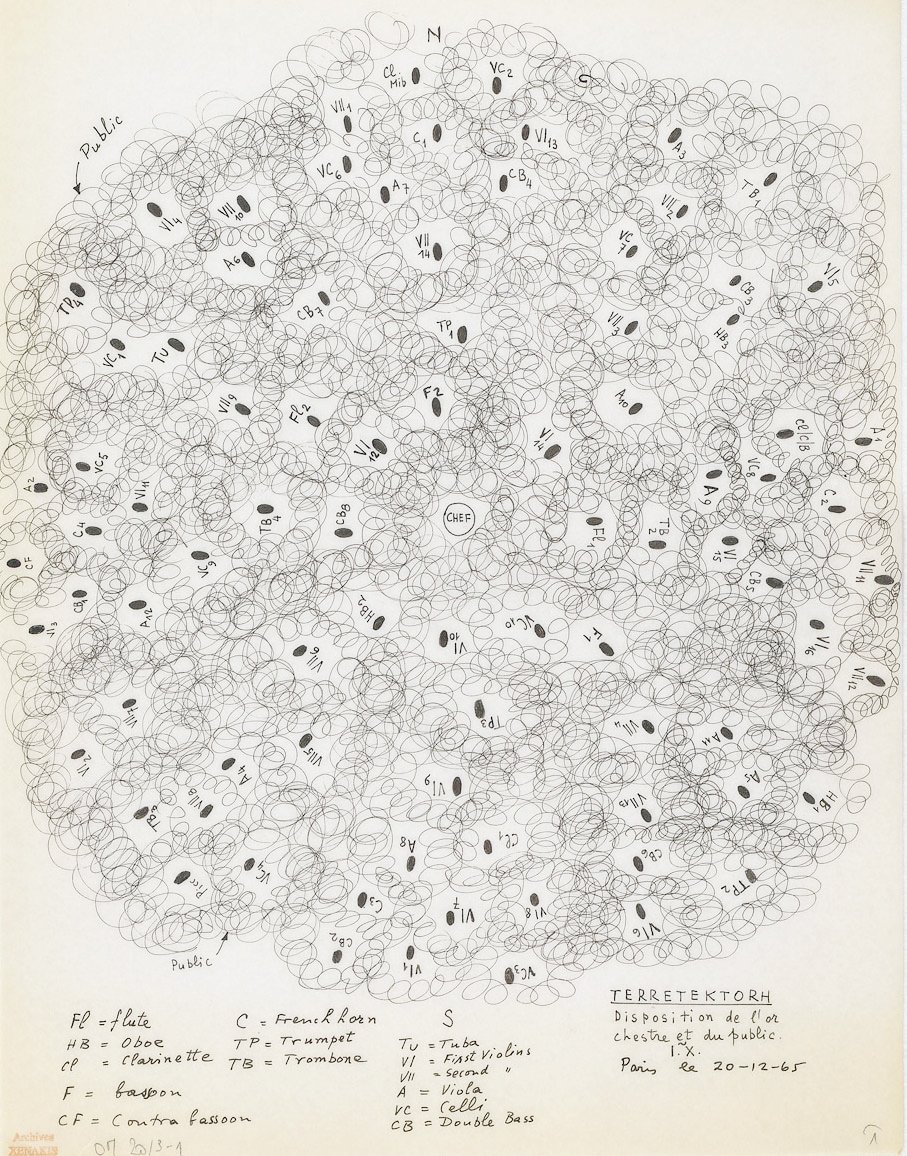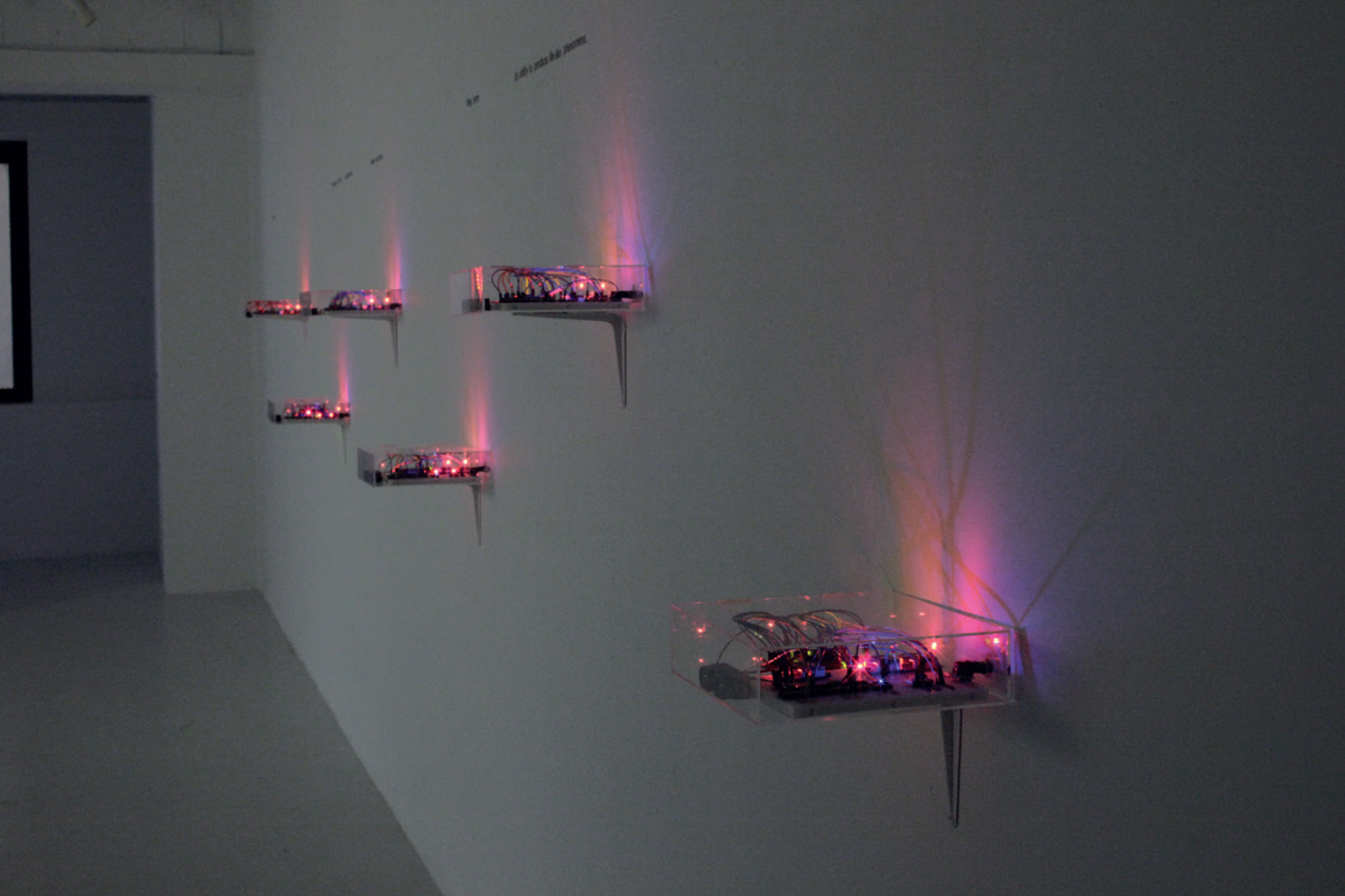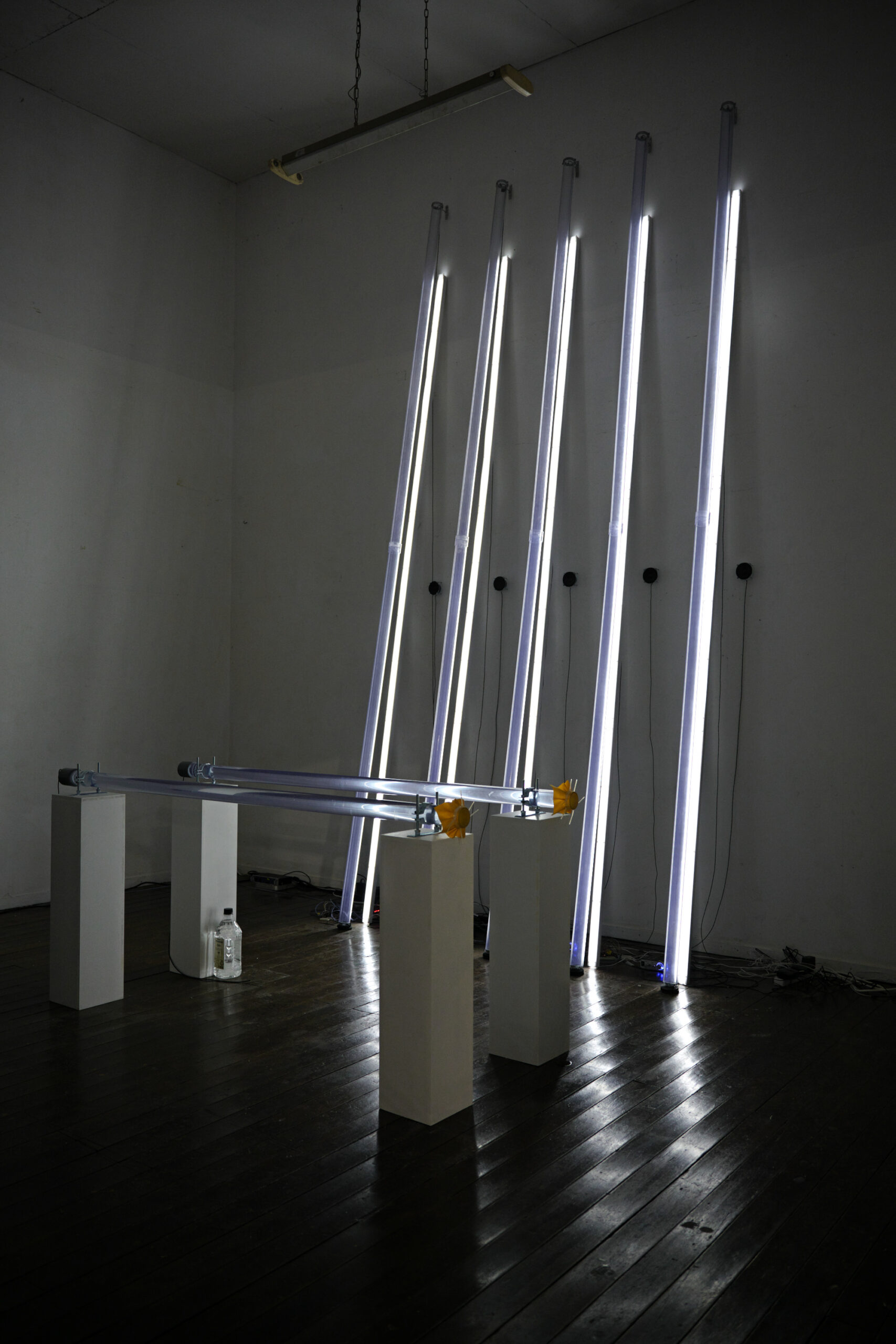owned this note
owned this note
Published
Linked with GitHub
# Report research fellowship 27.06 - 27.09
###### tags:`Fellowships`,`Japan`,`2022`
**Project Title:** Decentralised technologies in Japanese artistic practices
**Keywords:** Distributed Ledger Technologies, P2P, Blockchain, Algorithmic governance
**Priority research area:** Informatics, Media Design
## Re-decentralize Design: tools for a new spatial design practice In Japan
Original proposal from aplication 30.06.2021
### **Global Context**
Decentralized technologies is a term used to describe digital and spatial technologies which challenge the traditional centralized server model of prevailing software-hardware infrastructures. Examples of this range from Blockchain, which has been implemented successfully as alternative economic models for the current global monetary exchange, community peer to peer WiFi networks for participatory urbanism and more recently websites that could be hosted by their creators and be forked by others seamlessly. Peer to Peer (P2P) is a process or dynamic that can be found in many communities and movements self-organizing around the co-creation of culture and knowledge. Examples of this are the free/open source software movements and the Open Design and Open Source Architecture movement.
The history of informatics has been shaped by a constant flux between decentralized phases and centralizing phases such as the one experienced today with GAFAM and BATX, accumulating value over the exchanges of users and data on the web. Endeavours of centralization are also seen in the plans of some actors to propose urbanistic master plans through network infrastructures with the promise of efficiency. Decentralized technologies have been designed with a set of principles and values that contrast with the current political, labor and social ones of today’s world and are potentially the tools for a new phase of informatics.
This project proposal elaborates on an action based design research, operating a practical and theoretical inquiry on the roles of decentralized technologies and Peer to Peer networks within creative practices. The research aims to expand these artistic and design fields/practices from a technical perspective/standpoint producing both new knowledge and forms of social scenarios.
### **Research questions**
- How could P2P protocols, decentralized technologies and open source principles be used in the context of spatial design practices? How could this impact the current methodologies put in place?
- How could designers understand then appropriate these technologies for rethinking their workflows or adding them in their toolkit to solve design problems? How can designers’ methods help communicate the challenges of these technologies to the public, outside of academia?
- P2P Technologies by definition pose contraindications to current political and social dynamics; how are designers being affected by them? What speculative scenarios of collective design work could emerge from decentralized principles?
### **Japanese context**
Blockchain technology was implemented by japanese population very early when introduced through the white paper by the alias of Satoshi Nakamoto (Nakamoto 2009). To the point that by 2014, 70% of all Bitcoin transactions were handled by Mt Gox, a Bitcoin exchange firm in Shibuya. Almost 10 years have passed and japanese government has given new regulations to crypto currency exchange markets. While still making Japan a nation that excels using these technologies in the finance sector, less has been explored in using blockchain or other decentralised technologies in Design and artistic practices in Japan.
Tama University was one of the first higher institutions to the idea of merging hybrid creative practices with technology and Dr. Akihiro Kubota was part of this in 1998. He is a pioneer in the japanese and international scene of media arts by satellite art, bio art, digital fabrication, and sound performance with instruments he has invented. His practice and teaching in Tama are highly technical while also preserving a high degree of sensitivity of japanese tradition. Many of the research projects accomplished before by Akihiro Kubota are well known for having successfully bridge the world of informatics, engineering and the creative fields: An example of this is his initiative on sending the first artificial satellite for artistic experiments in space (ARTSAT1: INVADER).
### **Objectives & expected outcomes**
As part of my practice based research on decentralised technologies in arts and design, I would like to produce a piece within the lab of Information Design (Art and Media lab), being tutored by Dr. Kubota who has accepted to make me part of his pedagogical tasks such as doing critiques for master projects.
**Theoretical objective :** Understand the frameworks in which decentralised technologies such as Blockchain and P2P protocols exist in the practice of software art and media installations.
**Practical objective :** Create a piece using decentralised protocols that will be exposed in an art + engineering space in Japan ( space to be confirmed).
**Documentation objective :** Interview a designer, engineer and artist from Japan that could shed light on their relationships to each other in their practice. Focusing the discussion specifically in previous projects using Speculative design and advanced technical decentralised protocols.
### **Calendar** (Fellowship reduced to 3 months)
Month #1 :
- Meeting with Mr. Kubota and the research team
- Co-creating a plan of research
- Contacting the the possible peers for interviews (Ryoji Ikeda, Sputniko
- Organising workshop on P2P protocols to Tama students
Month #2 :
- Critiques to students from Media Arts course
- Production of piece
- first approach to art + science institutions ( The Earth-Life Science Institute (ELSI) & Kavli IPMU )
Month #3 :
- Critiques to students from Media Arts course
- Production of piece
- Workshop and talk at Tama and one of art + science institutions
Month #4 :
- Exhibitions of students
- Exhibition of produced piece
## COVID situation while in fellowship and fellowship reduced to 3 months
I was there when COVID measures such as masks where enforced by the local authorities.In august, as the numbers of cases of COVID went up, many universities where closed and relay on digital means for meetings and classes. On site events were also sometimes transformed into online events last minute.
It also important to note that while the inital proposal was for 4 months, my current contract as PhD candidate and assistant at the visual communication department made it very dificult to stay more than 3 months for a fellowship overseas.
## Research methodology
The methodology of my research departed from the concept of practice-based research in art & design where the production of pieces illustrates and gives support to arguments and hypothesis. There exists a tradition of "research on design", "research for design" and "research through design"(Cross, 1982, Frayling, 1993) in which my thesis prokect takes place, as is in an institutional context of a Swiss Federal Institutes of Technology and an Art & Design School. Given this the best way to ellaborate my research questions in Japan, was to create a piece, profiting of the know-hows and peers that I will meet in conferences and trough visits while on-site. The medium chosen for the piece as of the proposal was not set however while in Japan exchanging with the recently met peers and the media art class, Sound became evident as one that would benefit my research piece. Firstly, because sound has a quality of being invisible to the human eye however it could trigger to humans and non humans a feeling of space: sound as an agent of space. Secondly, theres a big field of studies on sound and landscapes from the cognitivie sciences that was also taken by artists and designers; Soundscape [(Schafer,1969)]() for example was theorised and practiced by Murray Shaffer and Pauline Oliveros [(Oliveros,1971)]() to conceptualise their practice. Thirdly, Sound has always has an emmiter, and I had the hypothesis that I could engage a discussion about agency on the technologies and agents that create sound and put it parallel to the agency that other agnets (human and non-human) have of the protocols that rule the connected world. The intention was to compare the *ambient networks* that connect trough an assamblages of protocols to the networks of *ambient sounds* that are omnipresent in the network of humans and non-humans agents that make the city.
In the next paragraphs I will make resumé on the diffents layers in which my research took place in Japan as I think that theres not a truly "indidual" research when the complexity of the research question imply the perspective of diffrent actors, being them academic, artistic bus also institutional
**Collective:** During my stay as a host researcher at Tama Art University I attended the Media Art class given my Akihiro Kubota-sensei and Akihiko Taniguchi. Master students of this class as well as one PhD candidate where invited once a week to show their updates on their individual research and also invited lecturers where invited to showcase their research and work. Putting in context my research and that of others was very helpful as I had the chance to get feedback and also learn to give it with an intracultural awareness. It was very helpful that the class uses an slack channel to share referecnes and ideas while we were not in Tama Campus.
I reached different laboratories on distributed computing with the intention to collaborate on an art & science framework and noticed that because my research was indirectly dwelling with subjects of decentralisation in economy it was not well received by many head of laboratories. Indeed, the tradition of scientific research in Japan is to avoid the subject of finance if is not their main field of research. Despite this, 佐藤 周行 / SATO Hiroyuki, Associate Professor from the Information Technology Center at Tokyo University responded positive to my demand to collaborate and offered Yepeng Ding (currently PhD Candidate) to work with me as of the production of the piece that was exhibited the 23.09.2022 at the gallery of Tama Art University.
**Individual:** To respond my research objectives of the fellowship in a respectful and caring way to the current place that was hosting me, I visited several exhibitions and schedule meetings with different actors of design and art in Japan within the first month to get an overview of the contemporary design and art practices. Very quickly I noticed that the term employed for the type of practice that Im doing is called *Art & Science* and is the result of the collaboration of creatives with advanced scientific research. The tradition of Arts & Sicences in Japan can be traced back to 1950 with movements such as Metabolism.
**Institutional:** Being a swiss based researcher and designer allow me to collaborate with the local representation of Swissnex whom had recently founded an Art & Science department at the consulate in Osaka. Their support was key in organizing a disucursive event with some of the actors that I thought could help to understand better Decentralised technologies in the context of the city and that where also using sound as one of their main mediums.
 Iannis Xenakis. Study for Terretektorh (distribution of musicians). December 20, 1965. Ink on vellum, 9 x 11 inches. Iannis Xenakis Archives, Bibliothèque nationale de France, Paris.
## Results and impacts of the research
### Installation: SOS (Sound on Sound) prototype produced with Yepeng Ding
The installation departed from the idea to sonify GAS data produced from a decentralized network, GAS refers to the unit that measures the amount of computational effort required to execute specific operations on the Ethereum network. Since each Ethereum transaction requires computational resources to execute, each transaction requires a fee. Gas refers to the fee required to conduct a transaction on Ethereum successfully[^1]. As the world was going through an Energy crisis in the wake of the Ukranian war, there was a fluctuation of this value that was changing in very unpredictable ways in the recent months as of the time of the fellowship.
In his book *Auditory Display: Sonification, Audification, and Auditory Interfaces* Gregory Kramer describes sonification as “the mapping of numerically represented relations in some domain under study to relations in an acoustic domain for the purpose of interpreting, understanding or communicating relations in the domain under study” [^2]. The way that we approach sonification was to to use it as an artisitic component o create tension in a generative environment. It was not used to create more clarity of the live data but to experience the data from the subjective perception of the public trough sound. The speakers volume was programmed to go in a circular direction creating an effect of mouvement towards the right direction when the GAS value went up and inversely to the towards the left when the gas value went down. The sound was created from a complex mathematical operation that was comparing the values of GAS to the previous generating a note in a scale predetermined.
The sound design came from 2 digital Roland devices that where connected via MIDI to the MaxMSP patch. It is important to note that although this sound could have been created in MaxMSP the choice was to use MIDI and Roland devices as it was co-invented by Ikutaro Kakehashi(founder of Roland) and allowed for interdependant devices to communicate between each other despite the manifacturer.The idea was to make a parallel to what HTTP was to the internet as we know today to what MIDI represents for music creation.
[^1]: https://ethereum.org/en/developers/docs/gas/#top
[^2]: G. Kramer, Auditory Display: Sonification, Audification, and Auditory Interfaces. Perseus, 1993.
**Materials for installation:**
6 speakers
2 Roland Synthesizers ( JU-06a & SH-01 )
16 Channel sound processor
Sound Mixer
**Materials for performance:**
Several different guitar pedals
Headless Guitar
**Software**
MaxMSP
NodeJS custom server
**Credits:**
Sound Design: Juan Gomez
Programming: Juan Gomez
Server programming: Yepeng Ding
#### Photo Documentation



#### Video Documentation
{%youtube vt3HUlF4Ojo %}
### Sonic Agency: Understanding the City through Sound Practices
My intention with this performative event, was to co-organize an event with Swissnex, Kubota-sensei and the speakers that will exhibit innovative views and perspectives to tackle some of the questions of technological agency through the means of a creative event. The event took place the 08.09.2022 in BnA_wall Art hotel in their gallery space. I designed the space to be a non hierarchical space in a circular fashion taking as reference the piece “Terretektorh” for 88 musicians (1966) by the Greek avant-garde composer [Iannis Xenakis (1922-2001)](https://en.wikipedia.org/wiki/Iannis_Xenakis). Audience( around 60 people) came from academic, artistic but also sound and techlogy enthusiasts. As part of the performative event I invited two sound artist to perform at the event while drinks and food was served. their performance was mainly ambient music from field recordings done in Budist rituals as well natural sounds from the nature nearby Kyoto.
I took the role of moderator for the Q&A and for the introduction of the event as I was the initiator of the concept for the overall event.








#### Presentation Slides of my introduction
https://juangomez.co/workshops/SonicAgency
#### Photo Documentation













#### Video Documentation
https://drive.google.com/drive/folders/1P8QA37Fj_2lO69G6njcOL0hkJ-SN8-NJ?usp=sharing
##### References:
METACITY (Yasushi Sakai, Ryuta Aoki, Masahiro Sasaki, Yusuke Fujiwara),New Rousseau Machine,The Exhibition of Jack into the Noösphere”, Chiba City,Toky,2021
https://yasushisakai.com/new_rousseau_machine.html
Takashi Ikegami, Mizuki Oka, Norihiro Maruyama, Yu Watanabe, Akihiko Matsumoto: Sensing the Sound Web,Gallery 7, Yaesu, 2012
https://digitalartarchive.siggraph.org/artwork/takashi-ikegami-mizuki-oka-norihiro-maruyama-yu-watanabe-akihiko-matsumoto-sensing-the-sound-web/
https://opensea.io/assets/ethereum/0x495f947276749ce646f68ac8c248420045cb7b5e/46953435361162808477144336071111186840368069729124709619705764616248137613313
ALTERNATIVE MACHINE “SNOWCRASH” (2021-2022) @ WHITEHOUSE, Tokyo – photo: Itsuki Doi
Robin Jungers, 64 Memories of Noise,Gallery 9.5, Kyoto,2022
https://qosmo.jp/en/surrender-kyoto/
Nao Tokui, Musical Ambience: Ambience for a Hotel,Gallery 9.5, Kyoto,2022
https://qosmo.jp/en/surrender-kyoto/

Marc Behrens,Tokyo Circle,Gallery 9.5,Sound Art – Sound as Media, ICC InterCommunication Center,Tokyo,2000
http://www.mbehrens.com/proj/tokyo_circle.html

Dr. Werner Kaegi – Vom Sinuston Zur Elektronischen Musik, 1971, Osaka Universal Exhibition, Osaka
https://www.youtube.com/watch?v=qs7DDG1znec&feature=youtu.be&ab_channel=BjarneSommerfeldt

Licaxxx,Production: Kazuki Muraoka,Dan Kubo,Sound Tectonics Installation #5, Yamaguchi Center for Arts & Media (YCAM), Yamaguchi, 2022
### Research Visits
Visit to exhibition **The Power of Surrendering — In between Active and Passive**
Gallery 9.5(HOTEL ANTEROOM KYOTO)
Attendeed to Surrender – The Ecstasy of Surrendering to Sound
18.07.2022
Nao Tokui|AI-Generative Live
AOKI Takamasa|DJ
Daito Manabe|DJ
Synth Sisters|Live
Ken Furudate|DJ
aluca|DJ
Robin Jungers|VJ
Ryosuke Nakajima|VJ
Interview with Robin Jungers
Visit to YCAM meeting with Interlab director and sound art expert
Visit to ICC
Meet Naohiro ( Osaka University of Arts)
Meet Kyoto Design Lab
Attended to talk by Daito Manabe, Lauren Lee Mcarthy and Kyle McDonald
Visit To Brian Eno Exhibition
1. Science always try to make a link with media arts
https://xlab.iii.u-tokyo.ac.jp/
https://metacity.jp/
https://ais-j.org/form/
2. Nice Artists
https://kaitosakuma-batic.com/recent-project
https://obake2ai.com/work
https://www.instagram.com/obake_ai/
http://dingshiwei.com/en/22-2/
3. Osaka Pavillion
https://www.kaegi.nl/werner/?Biography_%28English%29
 Sign in with Wallet
Sign in with Wallet

